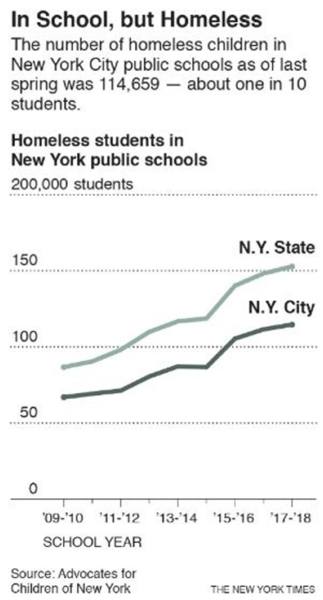Homeless in New York public schools at a record high: 114,659 students
The number of school-age children who are homeless has sharply increased in the last eight years

Of New York’s 1,800 schools, 144 have had the vast majority of homeless students in their classrooms over the last four years. (Representational)
Tonight, about one out of every 10 students in New York City will sleep in a homeless shelter or in the homes of relatives. That’s more children than at any other time since city records have been kept. In the morning, those same children will fan out across the city to go to school, some crossing multiple boroughs to get there.
Last year, the number of city students in temporary housing topped 100,000 for the third consecutive year, according to state data released Monday by Advocates for Children of New York, a group that provides legal and advocacy services for needy students.

Kourtney Kardashian moving to New York?
Reality TV star Kourtney Kardashian is reportedly considering moving from Calabasas in California to New York City.
Those students are the most vulnerable victims of homelessness, an issue that has dogged Mayor Bill de Blasio since he took office in 2014. But as the number of homeless children continues to swell, there hasn’t been a significant increase in public or private dollars spent to support these students.
Here’s a look at the issue of homelessness in the city’s schools, and what is — and isn’t — being done to reduce it:
There are more homeless students in New York City than people in Albany
The number of school-age children who are homeless has sharply increased in the last eight years along with a rise in homelessness overall. As politicians debate policy solutions, the number of students in temporary housing has ballooned to 114,659 students as of last spring, from 69,244 children in 2010.
That is more homeless students in New York City than the population of Albany.
New York City has one of the highest populations of homeless students of any big city in America. About 5 per cent of students in Chicago’s public schools were homeless last year, and just above 3 per cent of Los Angeles’ students were homeless in 2016.
There are about 1.1 million children in the city’s public schools in total.
The homelessness problem has left shelters at capacity and more people sleeping on streets and subways. Close to 38,000 homeless students lived in a shelter last year, down slightly from the previous year; the rest stayed with relatives while their families looked for permanent housing.
And in the last school year, there were 3,097 more students in temporary housing than in the 2016-17 school year.
“The problem of student homelessness is not going away,” said Randi Levine, the policy director of Advocates for Children.
At 144 public schools, a third of the children are homeless
Of New York’s 1,800 schools, 144 have had the vast majority of homeless students in their classrooms over the last four years. Homeless students tend to struggle academically: In the 2015-16 school year, just 12 per cent of students living in shelters passed the state math exam, and 15 per cent passed English.
In schools where at least 30 per cent of students are homeless, principals’ offices often double as informal counseling rooms for desperate parents and children.
At P.S. 446 in Brownsville, Brooklyn, where more than a quarter of the students are homeless, the principal, Meghan Dunn, described a daily race to meet the basic needs of her students.
“You think you’ve seen everything and then something happens where you’re like, ‘Well, I never saw that coming’, then it’s back to the drawing board to figure out what we can do,” she said.
Last year, Dunn said she got a call from a mother who was injured in a nearby homeless shelter and needed surgery. But when the mother was forced to find another shelter, her four children, all of whom attended P.S. 446, had to figure out a way to travel to the Bronx to apply for a new placement at the city’s sole intake center for homeless families, Dunn said.
Dunn sent one of her social workers to the shelter to help arrange a paid taxi ride to bring the injured mother and her children across the city, but the four students still missed several days of school. That was one of many emergency situations that Dunn said she dealt with that week.
In one Bronx school district, 10,804 students are homeless
School districts that have long served low-income students are absorbing more homeless students each year.
District 10 in the Bronx served the most homeless children of any of the city’s 32 school districts last year. The district includes Kingsbridge International High School, where about 44 per cent of students who attended the school over the last four years were homeless at one point.
More homeless students typically means more tardiness or absentees because of the challenges to get to school. Last year, students living in shelter missed an average of about 30 days in the school year.
Some students have to travel through two or more boroughs to reach school from their shelters; only about half of the city’s homeless families lived in a shelter in the same borough where their youngest child attended school last year. This fall, the city started a program to move more families into shelters no farther than 5 miles from their youngest child’s school.
For every 1,660 homeless students, there’s roughly 1 social worker
The city first earmarked $10.3 million for homeless students in 2016, and increased spending on social workers and other services for homeless students to $13.9 million last year, with the City Council pitching in about another $2 million from its own budget. For perspective, the Department of Education’s total budget for the current school year is $32.3 billion.
The amount set aside for services pays for about 70 social workers — or roughly one social worker for every 1,660 homeless students. The funding also pays for more after-school programs and additional staff to help homeless families apply to schools.
In addition, the city started to send students in kindergarten through sixth grade who were living in homeless shelters to school by bus in 2016.
But the mayor left that funding out of the city’s preliminary budget for the last two years, only to plug it back in the final budget, in a process critics call the budget dance.
Richard A. Carranza, the New York City schools chancellor, recently said he was startled by the lack in lines of support for homeless students when he took over the country’s largest public school system in the spring.
He found himself asking, “’Who owns that issue?’” he recalled in an August interview with The Times. “It was in three different departments,” Carranza added.
On Sunday, Carranza said the issue of students living in temporary housing was “deeply important” to him.
“We’re investing $16 million annually, increasing the number of social workers at schools with the highest rates of students in temporary housing, and bringing this work under the Office of Community Schools to address key challenges students and families face.”






 In the 2015-16 school year, just 12 per cent of students living in shelters passed the state math exam, and 15 per cent passed English.
In the 2015-16 school year, just 12 per cent of students living in shelters passed the state math exam, and 15 per cent passed English.




































No hay comentarios:
Publicar un comentario